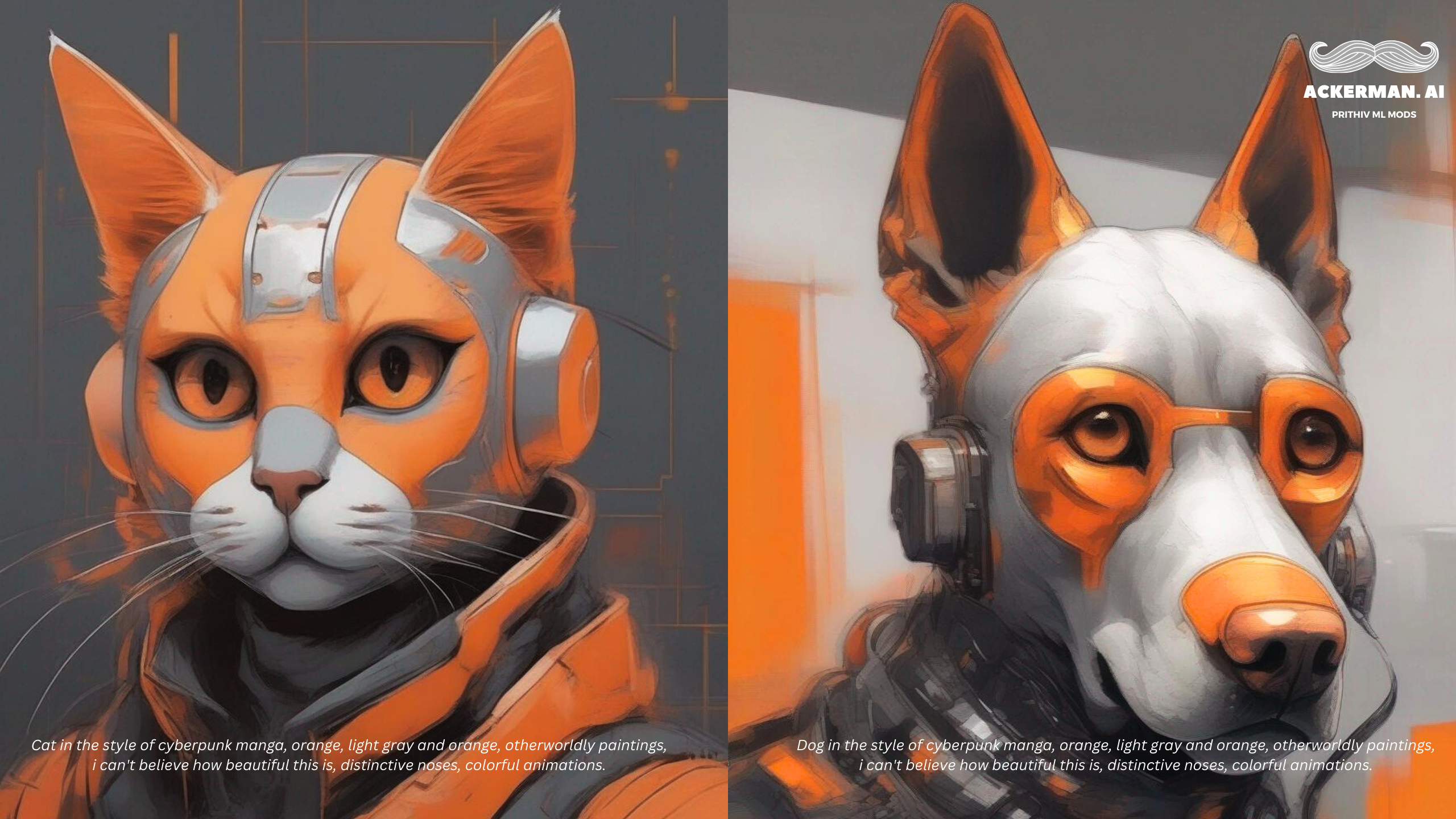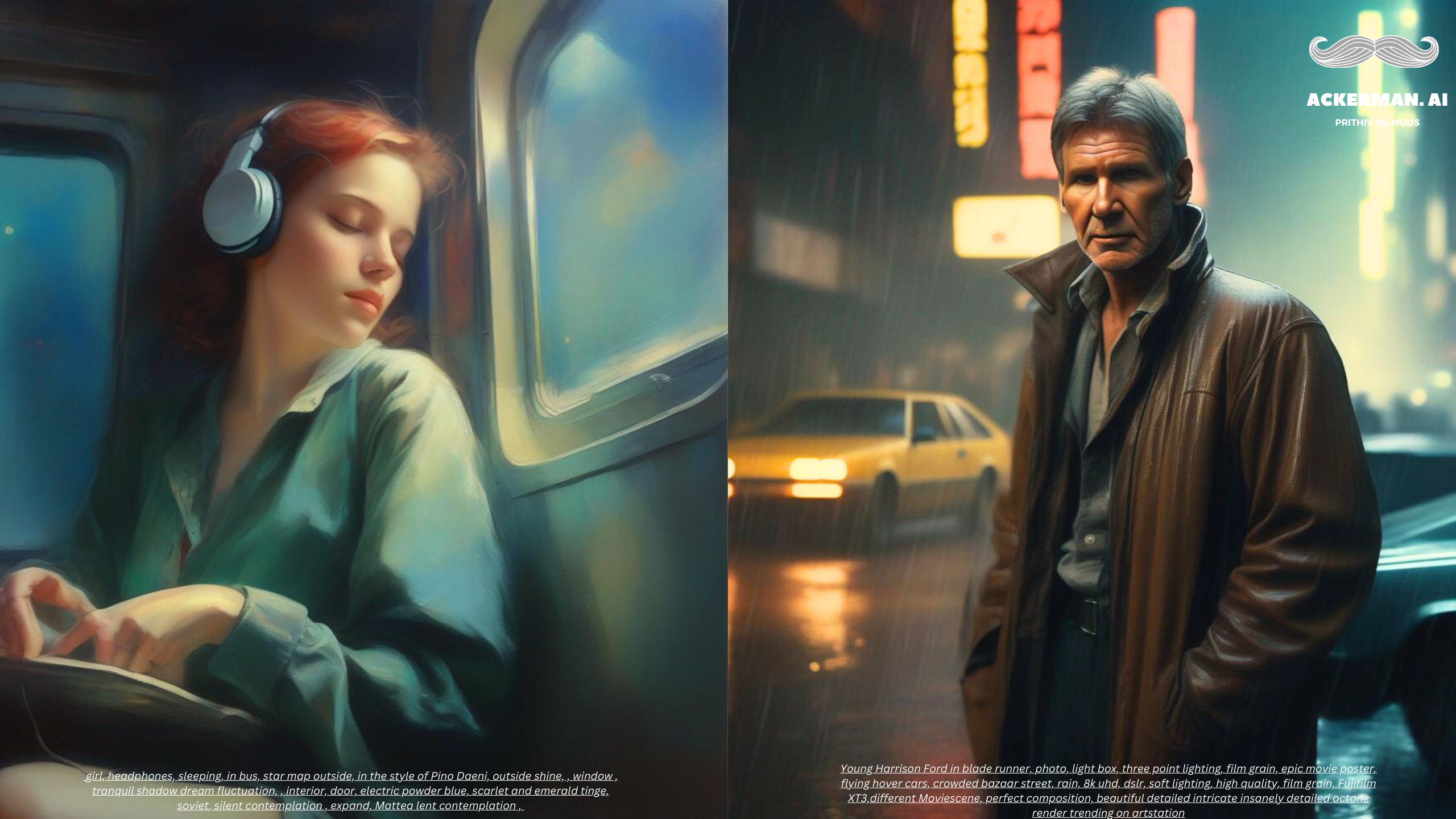ACKERMAN - SDXL 1.0
PINK CRATES CARD
INK CRATES CARD
CYBERPUNK CRATES CARD
ASTHETIC GOLD CRATES CARD
SUPER HEROS CRATES CARD
PHOTOGRAPHIC CRATES CARD
EVEN GENERATE SUNSETS
MODEL 0
SDXL consists of an ensemble of experts pipeline for latent diffusion: In a first step, the base model is used to generate (noisy) latents, which are then further processed with a refinement model specialized for the final denoising steps. Note that the base model can be used as a standalone module.
Alternatively, we can use a two-stage pipeline as follows: First, the base model is used to generate latents of the desired output size. In the second step, we use a specialized high-resolution model and apply a technique called SDEdit (https://arxiv.org/abs/2108.01073, also known as "img2img") to the latents generated in the first step, using the same prompt. This technique is slightly slower than the first one, as it requires more function evaluations.
MODEL DESCRIPTION
- Build Organization: LABS.ML (u_id: prithivMLmods)
- Model type: Diffusion-based text-to-image generative model
- License: [CreativeML Open RAIL++-M License]
- Model Description: This is a model that can be used to generate and modify images based on text prompts. It is a Latent Diffusion Model that uses two fixed, pretrained text encoders (OpenCLIP-ViT/G and CLIP-ViT/L).
- Resources for more information:SDXL report on arXiv.
MODEL REFERENCES [ IDEATION ]
- Previous Model Repository: https://huggingface.co/prithivMLmods/Yeager-StableDiffusion-ML676
- Demo: https://huggingface.co/blog/stable_diffusion
- Working References: -- stabilityai/stable-diffusion-xl-base-1.0 --
WORKING MODEL
 The figure above evaluates user preference for SDXL (with and without refinement) over SDXL 0.9 and Stable Diffusion 1.5 and 2.1.
The SDXL base model performs significantly better than the previous variants, and the model combined with the refinement module achieves the best overall performance.
The figure above evaluates user preference for SDXL (with and without refinement) over SDXL 0.9 and Stable Diffusion 1.5 and 2.1.
The SDXL base model performs significantly better than the previous variants, and the model combined with the refinement module achieves the best overall performance.
🧨 DIFFUSERS
Make sure to upgrade diffusers to >= 0.19.0:
pip install diffusers --upgrade
In addition make sure to install transformers, safetensors, accelerate as well as the invisible watermark:
pip install invisible_watermark transformers accelerate safetensors
To just use the base model, you can run:
from diffusers import DiffusionPipeline
import torch
pipe = DiffusionPipeline.from_pretrained("prithivMLmods/Ackerman-StableDiffusion-SDXL1.0", torch_dtype=torch.float16, use_safetensors=True, variant="fp16")
pipe.to("cuda")
# if using torch < 2.0
# pipe.enable_xformers_memory_efficient_attention()
prompt = "An astronaut riding a green horse"
images = pipe(prompt=prompt).images[0]
To use the whole base + refiner pipeline as an ensemble of experts you can run:
from diffusers import DiffusionPipeline
import torch
# load both base & refiner
base = DiffusionPipeline.from_pretrained(
"prithivMLmods/Ackerman-StableDiffusion-SDXL1.0", torch_dtype=torch.float16, variant="fp16", use_safetensors=True
)
base.to("cuda")
refiner = DiffusionPipeline.from_pretrained(
"prithivMLmods/Ackerman-StableDiffusion-SDXL1.0",
text_encoder_2=base.text_encoder_2,
vae=base.vae,
torch_dtype=torch.float16,
use_safetensors=True,
variant="fp16",
)
refiner.to("cuda")
# Define how many steps and what % of steps to be run on each experts (80/20) here
n_steps = 40
high_noise_frac = 0.8
prompt = "A majestic lion jumping from a big stone at night"
# run both experts
image = base(
prompt=prompt,
num_inference_steps=n_steps,
denoising_end=high_noise_frac,
output_type="latent",
).images
image = refiner(
prompt=prompt,
num_inference_steps=n_steps,
denoising_start=high_noise_frac,
image=image,
).images[0]
When using torch >= 2.0, you can improve the inference speed by 20-30% with torch.compile. Simple wrap the unet with torch compile before running the pipeline:
pipe.unet = torch.compile(pipe.unet, mode="reduce-overhead", fullgraph=True)
If you are limited by GPU VRAM, you can enable cpu offloading by calling pipe.enable_model_cpu_offload
instead of .to("cuda"):
- pipe.to("cuda")
+ pipe.enable_model_cpu_offload()
For more information on how to use Stable Diffusion XL with diffusers, please have a look at the Stable Diffusion XL Docs.
OPTIMUM
Optimum provides a Stable Diffusion pipeline compatible with both OpenVINO and ONNX Runtime.
OPEN-VINO
Open VINO
To install Optimum with the dependencies required for OpenVINO :
pip install optimum[openvino]
To load an OpenVINO model and run inference with OpenVINO Runtime, you need to replace StableDiffusionXLPipeline with Optimum OVStableDiffusionXLPipeline. In case you want to load a PyTorch model and convert it to the OpenVINO format on-the-fly, you can set export=True.
- from diffusers import StableDiffusionXLPipeline
+ from optimum.intel import OVStableDiffusionXLPipeline
model_id = "prithivMLmods/Ackerman-StableDiffusion-SDXL1.0"
- pipeline = StableDiffusionXLPipeline.from_pretrained(model_id)
+ pipeline = OVStableDiffusionXLPipeline.from_pretrained(model_id)
prompt = "A majestic lion jumping from a big stone at night"
image = pipeline(prompt).images[0]
You can find more examples (such as static reshaping and model compilation) in optimum documentation.
ONNX
To install Optimum with the dependencies required for ONNX Runtime inference :
pip install optimum[onnxruntime]
To load an ONNX model and run inference with ONNX Runtime, you need to replace StableDiffusionXLPipeline with Optimum ORTStableDiffusionXLPipeline. In case you want to load a PyTorch model and convert it to the ONNX format on-the-fly, you can set export=True.
- from diffusers import StableDiffusionXLPipeline
+ from optimum.onnxruntime import ORTStableDiffusionXLPipeline
model_id = "prithivMLmods/Ackerman-StableDiffusion-SDXL1.0"
- pipeline = StableDiffusionXLPipeline.from_pretrained(model_id)
+ pipeline = ORTStableDiffusionXLPipeline.from_pretrained(model_id)
prompt = "A majestic lion jumping from a big stone at night"
image = pipeline(prompt).images[0]
You can find more examples in optimum documentation.
USES
DIRECT USE
The model is intended for research purposes only. Possible research areas and tasks include
- Generation of artworks and use in design and other artistic processes.
- Applications in educational or creative tools.
- Research on generative models.
- Safe deployment of models which have the potential to generate harmful content.
- Probing and understanding the limitations and biases of generative models.
Excluded uses are described below.
OUT-OF-SCOPE USE
The model was not trained to be factual or true representations of people or events, and therefore using the model to generate such content is out-of-scope for the abilities of this model.
GPU COMPUTATION SCHEMA
To calculate the computational time for GPU-based machine learning tasks such as stable diffusion, you need to consider several factors including the complexity of your model, the size of your dataset, the hardware specifications of your GPU, and the efficiency of your implementation.
Here's a general formula to estimate the computational time: Computational Time = Number of iterations × Time per iteration / Number of GPU’s
Where:
Number of iterations: This refers to the number of iterations or epochs your machine learning algorithm will run for.
Time per iteration: This is the time taken by your algorithm to complete one iteration on a single GPU.
Number of GPUs: The number of GPUs you're using for computation.
LIMITATIONS
- The model does not achieve perfect latent sync
- The model cannot render legible text
- Faces and people in general may not be generated properly.
- The autoencoding part of the model is lossy.
BIAS
While the capabilities of image generation models are impressive, they can also reinforce or exacerbate social biases.
MODEL STRUCTURE
Files & Version Integrated :
feature_extractor (folder) |- preprocessor_config.json (file) safety_checker/ |--- config.json (4.72 kB) |--- demo.txt (0 Bytes) |--- model.fp16.safetensors (608 MB) [LFS] |--- model.safetensors (1.22 GB) [LFS] |--- pytorch_model.bin (1.22 GB) [LFS] |--- pytorch_model.fp16.bin scheduler └── scheduler_config.json text_encoder/ ├── config.json (616 Bytes) ├── demo.txt (0 Bytes) └── pytorch_model.bin (246 MB) [Large File Storage (LFS)] tokenizer ├── demo.txt (0 Bytes) ├── merges.txt (525 kB) ├── special_tokens_map.json (472 Bytes) ├── tokenizer_config.json (737 Bytes) └── vocab.json unet/ ├── config.json ├── demo.txt └── diffusion_pytorch_model.bin vae/ |__ config.json |__ demo.txt |__ diffusion_pytorch_model.bin .
CONCLUSION
The model is age violated, and the results to your prompt are at your own risk. [ Think before prompting the violated content ]
The model is re-designed [ SDXL 1.0 ] only for productivity purposes.
- Downloads last month
- 291








